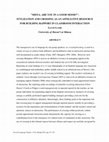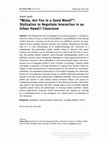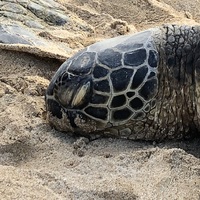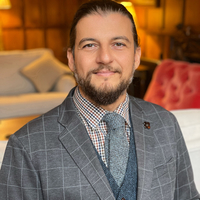Papers by Gavin Lamb
Selected papers from the fourteenth annual college-wide conference for students in languages, lin... more Selected papers from the fourteenth annual college-wide conference for students in languages, linguistics & literature at the University of Hawai`i

This chapter maps the emerging conceptual terrain of posthumanism and its relevance for discourse... more This chapter maps the emerging conceptual terrain of posthumanism and its relevance for discourse studies, with a particular focus on sociolinguistics and applied linguistics work. Posthumanism is a label applied to a range of theoretical and methodological approaches across the humanities and social sciences that are calling into question dominant assumptions generated by Western Enlightenment thinking about the human by giving greater consideration to the role of material objects, animals and the environment in understanding the social world. Posthumanism thus considers the implications of the central role of materialism in our understandings of human agency, language, cognition and society. For discourse studies, a turn to posthumanism requires us to examine the role of discourse in how humans become entangled with the material world through their everyday embodied interactions with objects, artifacts, technologies, plants, animals, and the built and natural environment. Through embracing an activity-oriented perspective toward these human–nonhuman entanglements, the implications are that we must rethink modernist categorical boundaries between subject/object, human/nonhuman and society/nature, both within metadiscourses about these dichotomies and through a more microanalytic lens in the analysis of text and talk.
Applied Linguistics Review, 2019
This special issue builds on sociolinguistic research in tourism, semiotic landscapes, language m... more This special issue builds on sociolinguistic research in tourism, semiotic landscapes, language materiality, and multilingual and multimodal practices to explore how spaces for tourism are formed at the nexus of language and the material world.

Emotion in Multilingual Interaction, 2016
Recent conversation-analytic research has examined the projective aspects of multimodal interacti... more Recent conversation-analytic research has examined the projective aspects of multimodal interaction within and between turn-sequences (Streeck 2009a) as well as affectivity or emotive involvement in conversational storytelling (Selting 2010). Taking a perspective on face-to-face interaction as sequentially organized, multimodal, and embedded in various semiotic systems, this study examines how the projection of particular affective stances emerges in naturally-occurring interactional storytelling. Through close analysis of video-recorded data of a conversation between an American man and a Japanese woman, the chapter aims to shed light on this relatively underexplored area of talk between L1 and L2 speakers by elucidating the “crescendo” or build-up of projective linguistic and paralinguistic resources used in the co-construction of intersubjectivity and “humorous” affect within the activity of storytelling.
Journal of Language and Politics, 2012

Applied Linguistics Review, 2019
This paper examines the discursive practices of sea turtle ecotourism that transform a beach in H... more This paper examines the discursive practices of sea turtle ecotourism that transform a beach in Hawai‘i into a popular sea turtle tourism destination. I analyze the circulation of an ecotourism discourse of spectacular nature that cycles through several distinct circuits of discursive remediation to produce Laniākea Beach as a sea turtle tourism destination. This ecotourism discourse entangles sea turtles and people into a discursive-material infrastructure of spectacular nature which the sea turtle tourism industry in Hawai‘i enlists to commodify human encounters with this charismatic species. Bringing complementary approaches in ecotourism studies and mediated discourse analysis that take human-nonhuman embodied (inter)actions as a starting point for discourse analysis, I trace how this ecotourism discourse itinerates across three distinct circuits of sea turtle tourism: (1) commercial tourism representations (on websites, guidebooks and street advertising), (2) in tourists’ embod...

The transgressive use of language by out-group speakers, or crossing/mocking, is used in a variet... more The transgressive use of language by out-group speakers, or crossing/mocking, is used in a variety of ways to achieve both affiliative and disaffiliative ends in interaction and has been well documented in youth culture (Chun, 2007; Rampton 1995, 2006). However, how crossing (Rampton 1995) is used as an affiliative resource in managing rapport in the assymetrical relations between teachers and students has yet to be fully investigated. Reporting on some findings of a 1.5 year ethnography of an English/ language arts classroom at a multilingual and multiethnic public middle school in an urbanized area of Hawai‘i, this paper explores one teacher's use of crossing in building rapport. The teacher's stylization of students' voices through ventriloquizing (Tannen 2007) is seen to be an affiliative resource in managing rapport (Gunther 2008) when strategically embedded in ritual oppositional frames of interaction. By exploring audio-recordings of naturally occurring interactio...
Language in Society, 2017

Multilingua, 2015
The transgressive use of language by out-group speakers, or crossing is used in a variety of ways... more The transgressive use of language by out-group speakers, or crossing is used in a variety of ways to achieve both affiliative and disaffiliative ends among youths. However, crossing can also be used as an affiliative resource in asymmetrical power relations between teachers and students. Reporting on the findings of a 1.5 year ethnography of an English/language arts classroom at a multilingual and multiethnic public middle school in Hawai’i, this paper explores one teacher’s use of stylization practices which take the form of crossing. The teacher stylizes students’ voices through ventriloquizing, which is an affiliative resource when strategically embedded in ritual oppositional frames of interaction. However, when embedded in other interactional frames, this transgressive use of language results in acts of insult or mocking. I analyze audio recordings of naturally occurring interaction to explore how Hawai’i Creole (or Pidgin) is used transgressively in reported speech by the teac...
Language and Intercultural Communication in Tourism, 2021

Applied Linguistics, 2019
This article argues that human–animal relationships are a key conceptual terrain for applied ling... more This article argues that human–animal relationships are a key conceptual terrain for applied linguists to intervene in emerging interdisciplinary debates on how to address problematic human–environment relations in a time of growing ecological degradation. The scientific diagnosis of the Anthropocene has further generated critical discussion in the social sciences on the need to understand the diversity of local cultural responses to global environmental crises, ranging from climate change to species extinction. This article proposes that a ‘green applied linguistics’ can offer empirical insights into the role of language and discourse in mediating diverse human relationships with animals and nature. Taking human interactions with protected wildlife as one aspect of these wider socio-environmental debates, this article builds on recent embodied, materialist and posthumanist research in applied linguistics to suggest that nexus analysis offers a holistic methodology to examine the problematic ways people become caught up with threatened species through their semiotic practices. I illustrate these ideas through examples from my ethnographic research on the convergence of sea turtle conservation and ecotourism practices at Laniākea Beach, Hawai‘i.
Applied Linguistics Review, 2019
This special issue builds on sociolinguistic research in tourism, semiotic landscapes, language m... more This special issue builds on sociolinguistic research in tourism, semiotic landscapes, language materiality, and multilingual and multimodal practices to explore how spaces for tourism are formed at the nexus of language and the material world.

Applied Linguistics Review, 2019
This paper examines the discursive practices of sea turtle ecotourism that transform a beach in H... more This paper examines the discursive practices of sea turtle ecotourism that transform a beach in Hawai‘i into a popular sea turtle tourism destination. I analyze the circulation of an ecotourism discourse of spectacular nature that cycles through several distinct circuits of discursive remediation to produce Laniākea Beach as a sea turtle tourism destination. This ecotourism discourse entangles sea turtles and people into a discursive-material infrastructure of spectacular nature which the sea turtle tourism industry in Hawai‘i enlists to commodify human encounters with this charismatic species. Bringing complementary approaches in ecotourism studies and mediated discourse analysis that take human-nonhuman embodied (inter)actions as a starting point for discourse analysis, I trace how this ecotourism discourse itinerates across three distinct circuits of sea turtle tourism: (1) commercial tourism representations (on websites, guidebooks and street advertising), (2) in tourists’ embodied encounters with sea turtles (touching, pointing at, swimming with and talking about actual sea turtles), and (3) through online remediation of these embodied encounters (on social media platforms like Instagram and Facebook). The study suggests implications for how embodied and material approaches to discourse analysis in applied linguistics can bring empirical focus to the (un)ethical dimensions of wildlife ecotourism practices.

Multilingua, 2015
The transgressive use of language by out-group speakers, or crossing is used in a variety of ways... more The transgressive use of language by out-group speakers, or crossing is used in a variety of ways to achieve both affiliative and disaffiliative ends among youths. However, crossing can also be used as an affiliative resource in asymmetrical power relations between teachers and students. Reporting on the findings of a 1.5 year ethnography of an English/language arts classroom at a multilingual and multiethnic public middle school in Hawai’i, this paper explores one teacher’s use of stylization practices which take the form of crossing. The teacher stylizes students’ voices through ventriloquizing, which is an affiliative resource when strategically embedded in ritual oppositional frames of interaction. However, when embedded in other interactional frames, this transgressive use of language results in acts of insult or mocking. I analyze audio recordings of naturally occurring interaction to explore how Hawai’i Creole (or Pidgin) is used transgressively in reported speech by the teacher, an “out-group” individual, for negotiating interactions in his English language arts classroom. Instances of transgressive language emerge as artfully performed strategies that provide a rich site for the construction of affiliative identities. The use of crossing allows the teacher to take liminal stances between offense and respect to strategically manage student participation in this diverse classroom. These findings point to the important role that crossing plays in acts of identity through reported speech where the performance of crossing within positively valued, jocular oppositional classroom rituals demonstrates the capacity for crossing as a contributing factor to the emergence of a shared sense of community in the classroom.
Book Chapters by Gavin Lamb

The Cambridge Handbook of Discourse Studies, 2020
This chapter maps the emerging conceptual terrain of posthumanism and its relevance for discourse... more This chapter maps the emerging conceptual terrain of posthumanism and its relevance for discourse studies, with a particular focus on sociolinguistics and applied linguistics work. Posthumanism is a label applied to a range of theoretical and methodological approaches across the humanities and social sciences that are calling into question dominant assumptions generated by Western Enlightenment thinking about the human by giving greater consideration to the role of material objects, animals and the environment in understanding the social world. Posthumanism thus considers the implications of the central role of materialism in our understandings of human agency, language, cognition and society. For discourse studies, a turn to posthumanism requires us to examine the role of discourse in how humans become entangled with the material world through their everyday embodied interactions with objects, artifacts, technologies, plants, animals, and the built and natural environment. Through embracing an activity-oriented perspective toward these human–nonhuman entanglements, the implications are that we must rethink modernist categorical boundaries between subject/object, human/nonhuman and society/nature, both within metadiscourses about these dichotomies and through a more microanalytic lens in the analysis of text and talk.

Recent conversation-analytic research has examined the projective aspects of multimodal interacti... more Recent conversation-analytic research has examined the projective aspects of multimodal interaction within and between turn-sequences (Streeck 2009a) as well as affectivity or emotive involvement in conversational storytelling (Selting 2010). Taking a perspective on face-to-face interaction as sequentially organized, multimodal, and embedded in various semiotic systems, this study examines how the projection of particular affective stances emerges in naturally-occurring interactional storytelling. Through close analysis of video-recorded data of a conversation between an American man and a Japanese woman, the chapter aims to shed light on this relatively under explored area of talk between L1 and L2 speakers by elucidating the “crescendo” or build-up of projective linguistic and paralinguistic resources used in the co-construction of intersubjectivity and “humorous” affect within the activity of storytelling.











Uploads
Papers by Gavin Lamb
Book Chapters by Gavin Lamb
References
Martin, J. R. (2004). Positive discourse analysis: Solidarity and change. Revista Canaria de Estudios Ingleses, 49(1), 179-202.
Aims of project
• Using corpus linguistic methodologies, Robert Lawson’s principal aim in this project is to better understand the salient discursive strategies used on Twitter about Greta Thunberg, including hashtags, collocations and keywords, and how such methods can help inform subsequent analytical foci to hone in on specific moments of ideological positioning.
• Drawing on the analytical tools of Systemic Functional Linguistics as well as Legitimation Code Theory, Eszter Szenes’ aim is to analyse the linguistic construction of values, attitudes and emotions to reveal Twitter users’ alignment into particular sub-cultures and their affiliation with or resistance against Greta Thunberg and the broader climate action movement inspired by her.
• In this project, Gavin Lamb applies nexus analysis to examine the far-right environmental discourses that Twitter users circulate through negative tweets about Greta Thunberg in order to build oppositional ecopolitical identities and communities.
Research Team
Dr Robert Lawson (School of English, Birmingham City University, Birmingham, UK) draws on multi-disciplinary approaches, including sociolinguistics, corpus linguistics, narrative analysis, and critical discourse analysis, to investigate linguistic practice in online spaces, particularly on Twitter, Reddit and community forums. He is interested in how language use is connected to broader notions of gender and identity, how resistance and alignment are strategically constructed, and how online spaces become sites of political and social contestation.
Dr Eszter Szenes (Peace & War Centre, Norwich University, VT USA/Department of Sociology and Social Anthropology, Central European University, Vienna, Austria from 03/2020) is interested in identifying radicalisation strategies in online far-right propaganda, in order to gain a deep understanding of its linguistic repertoire and contribute to its prevention. She is particularly interested in examining how the radicalisation strategies of the European far-right deploy a wide range of nuanced semiotic, linguistic and visual meaning-making resources in order to recruit potential new members.
Dr Gavin Lamb's (Department of Second Language Studies, University of Hawai‘i at Mānoa, USA) main area of interest is the discursive practices mediating human relationships with animals and nature across offline and online spaces. He is particularly interested in developing nexus analysis to examine the digital practices people engage in to create social identities and communities in relation to environmental issues such as endangered species protection and climate activism.